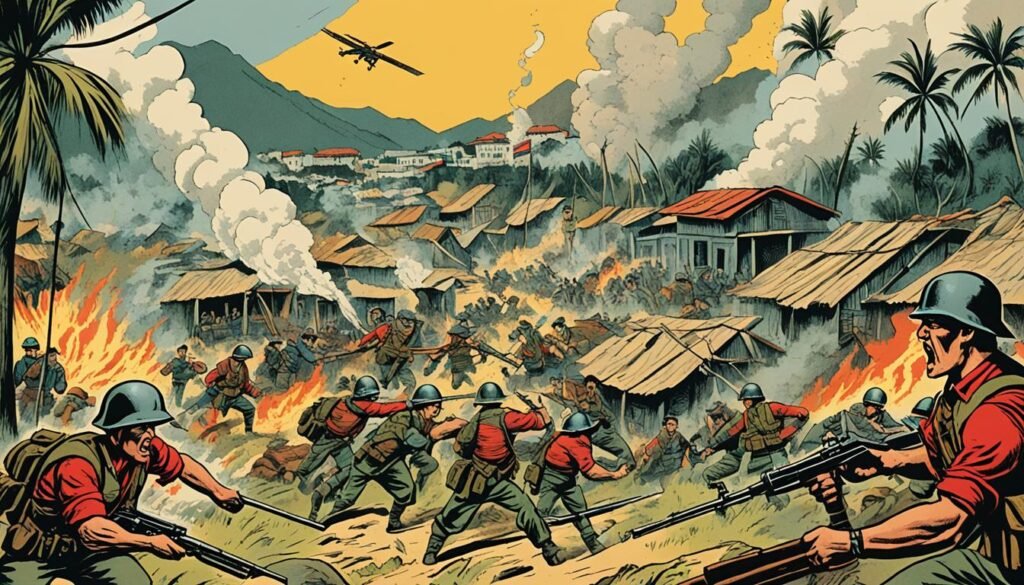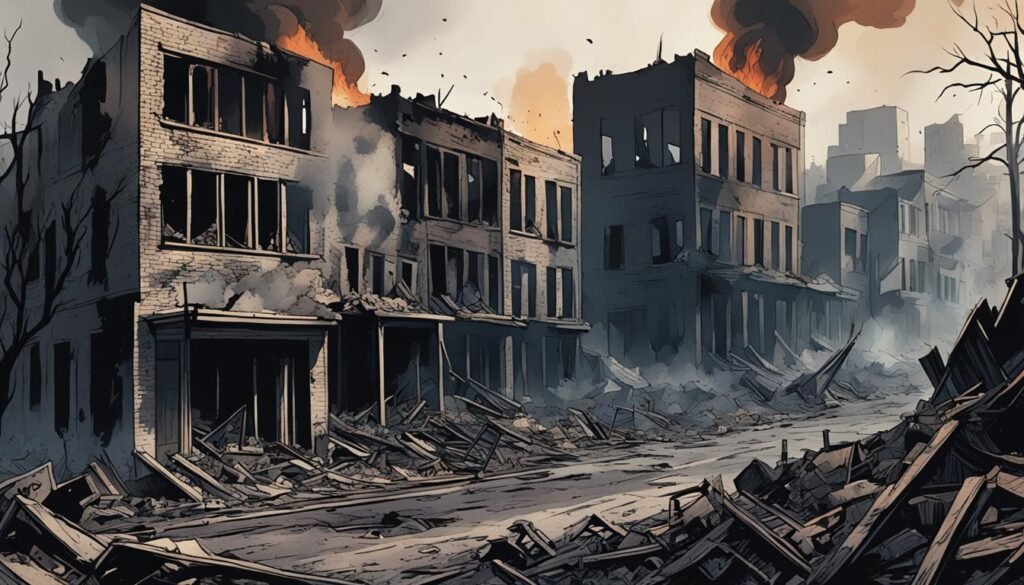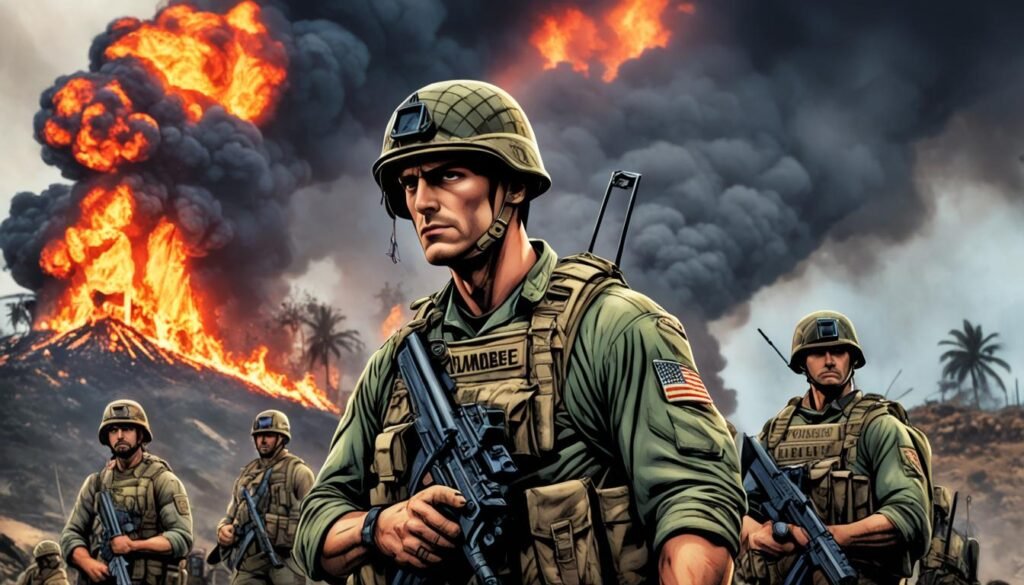Around 300 people from Macabebe were killed by fire in their church on April 27, 1899. This sad event, called the Burning of The 300 Macabebes, marked a key time in Philippine history. It was during the struggle for Philippine independence. The Macabebes, soldiers from Macabebe in Pampanga, faced this terrible fate in the Philippine-American War. Since then, there’s been much talk and debate about it, especially concerning the Macabebe Scouts and the “Dugong Aso” issue.
Key Takeaways
- The Burning of The 300 Macabebes was a tragic event during the Philippine-American War, where around 300 Filipino revolutionaries were burned alive in a church.
- The Macabebes, a group from the town of Macabebe in Pampanga, were the victims of this horrific incident, which has remained a controversial and debated topic in Philippine history.
- The event was a significant moment in the fight for Philippine independence and has had a lasting impact on the town and its people.
- The Macabebe Scouts and the “Dugong Aso” label have played a crucial role in the ongoing discourse surrounding this historical event.
- The story of the Burning of The 300 Macabebes offers valuable lessons and reflections on the consequences of division, prejudice, and the importance of empathy and reconciliation.
The Town of Macabebe
Located in Pampanga province, the town of Macabebe sits at Manila Bay’s mouth. This spot was very important in Macabebe’s history. During the colonial era and the Philippine-American War, it was a key area of control.
Location and Geography
Macabebe is in the Pampanga province of the Philippines. As of 2020, it had 78,151 people. The town is quite dense, with 740 people per square kilometer or 1,900 per square mile. Its coastal location has always made it a big deal for trade and control, way back during colonial times.
Early History and Origins
Macabebe’s story starts with the Kapampangan people who lived there. They’ve had a strong, unique culture for centuries. Over time, they mixed with the Spanish and Americans, among others.
| Statistic | Value |
|---|---|
| Total Population (2020 census) | 78,151 |
| Population Density | 740 inhabitants per sq km or 1,900 inhabitants per sq mile |
| Poverty Incidence (2018) | 5.50% |
| Revenue (2020) | ₱217.2 million |
| Assets (2020) | ₱252.5 million |
| Expenditure (2020) | ₱228.5 million |
| Liabilities (2020) | ₱72.75 million |
| Religious Breakdown | Catholics 82%, Members Church of God International 5%, Iglesia ni Cristo 8%, Evangelicals 2%, others 3% |
| Average Daily Maximum Temperature | 28°C (82°F) to 33°C (91°F) |
| Average Daily Minimum Temperature | 20°C (68°F) to 24°C (75°F) |
| Average Annual Precipitation | 792 mm (31.1 inches) |
| Population Growth Rate (2015-2020) | 0.59% |
Spanish Colonial Rule
During the Spanish colonial era, Macabebe and its people, the Macabebes, had a special link with the colonial powers. At first, they fought against Spanish colonialism in the Philippines. The young from the town were the first to stand for freedom in the Battle of Bangkusay in 1571.
The Voluntarios de Macabebe
Later on, the Macabebes gained a new title, the Macabebe Voluntarios. This group were volunteer soldiers for the Spanish colonizers. They changed sides, supporting the Spanish by offering important military help and secrets.
Involvement in the Philippine Revolution
The mixed link between the Macabebes and the colonial powers continued during the Philippine Revolution. Some Macabebes joined the fight for freedom, while others stayed loyal to the Spanish and later the Americans. This created a split loyalty within the town during this rocky part of Philippine history.

The Philippine-American War
In the Philippine-American War, the town of Macabebe was key. The Macabebes aligned with the U.S. after their town was burned in 1899. 300 people were also killed by Filipino forces at that time.
Macabebes’ Role in the War
Known as the Macabebe Scouts, this group helped the U.S. fight Filipino rebels. In June 1898, Lieutenant Matthew Batson brought 92 of them into the U.S. forces. They were crucial and even captured Emilio Aguinaldo, president of the First Philippine Republic, in 1901.
Formation of the Macabebe Scouts
The Macabebe Scouts were loyal and skillful. They later became part of the U.S. Army as the Philippine Scouts. They served well in World War II too. Their help in the Philippine-American War helped the U.S. and Filipinos be allies against Spain for over four months.
Motivations and Reasons for Siding with Americans
After their town was burned and 300 were killed, the Macabebes turned to the U.S. for protection. They saw the U.S. as a new power that could keep them safe from more harm. This was partly because they had a mixed past with the Spanish rulers.
The Macabebe Scouts were also great at making peace. They helped control weapons from the Moro tribes after the war. This showed they could work well in different situations.
The Burning of The 300 Macabebes
Events Leading to the Burning
On April 27, 1899, The Burning of The 300 Macabebes took place during the Philippine-American War. Filipinos, led by General Antonio Luna, struck Macabebe for allegedly working with the Spaniards and Americans. About 300 locals died when the revolutionaries set a church on fire, as per the National Historical Commission of the Philippines.
Accounts and Eyewitness Reports
Historian Ian Christopher Alfonso wrote extensively on the Burning in his book. He used various sources to detail the events and background of the tragedy. His work sheds light on deep-rooted biases against the Macabebe people.
General Antonio Luna had also burned other towns and churches during the war. But the destruction in Macabebe stood out, called Luna’s “sword and fire,” by General Frederick Funston. This attack was confirmed during a speech in New York in 1902. Photos by Luther Parker with notes from 1901 back this up.
Descendants tell of the horrific event, saying people were trapped in a church and burned alive. There’s mention of a General Kalintog or Kalentong, believed to be Colonel Agapito Bonzon. He was tied to the event and was part of the capture of Macabebe earlier, according to historical records.

Aftermath and Legacy
The Burning of The 300 Macabebes deeply affected Macabebe and its people. It caused a lot of suffering, including the loss of lives and harm to those left. The Philippine-American War that came after made things even worse for them.
Impact on the Town and its People
This tragic event left a permanent mark on the town and its folks. The deaths, especially of women and kids, hit them hard. They struggled to move on, with fear and division growing during the war.
The Burning of The 300 Macabebes forever changed how people saw the town. Those from Macabebe were called traitors by some, even though they fought bravely before. This debate and its impact continue across the Philippines.
Yet, the Macabebe people worked hard to keep their culture and spirit alive. They look to the future, seeking to overcome their difficult history. Healing old wounds and moving forward is their goal, despite the past tragedy.
Controversy and “Dugong Aso” Label
The Burning of The 300 Macabebes sparks controversy and debate in the Philippines. The town and people face historical revisionism and negative labels. For a long time, the Macabebes have been called “Dugong Aso,” meaning “Dog-Like.”
Historical Revisionism and Debates
The Macabebes’ role in the Philippine-American War is often reinterpreted over time. Some paint them as traitors, while others say they faced tough choices. These discussions are often influenced by politics and have stirred ongoing arguments.
The reexamination of history also questions The Burning of The 300 Macabebes. Some doubt the event’s truth or say it’s less important. This lack of agreement continues to complicate the story of the Macabebes.
The Macabebe controversy and the “Dugong Aso” label show a deeper issue with how we view history. They lead to ongoing discussion and sometimes division around the Macabebes’ place in the nation’s story.
National Historical Commission Marker
The National Historical Commission of the Philippines (NHCP) honored the Burning of The 300 Macabebes. They placed a marker at the San Nicolas de Tolentino church in Macabebe, Pampanga. This event happened on April 27, 2022, marking the 125th year since this tragic event.
Unveiling Ceremony and Significance
The ceremony to unveil the Macabebe marker was a somber event. It was hosted by the NHCP. It acknowledged the historical importance of the Burning of The 300 Macabebes. This allowed the community and the country to remember this sorrowful time.
The installation of the marker was a powerful action. It showed the government’s commitment to preserving this painful part of history. The marker symbolized more than remembrance; it was a step towards understanding and unity amidst a troubled past.
| Key Details | Description |
|---|---|
| Event | Unveiling of the Macabebe Marker by the National Historical Commission of the Philippines |
| Location | San Nicolas de Tolentino church, Macabebe, Pampanga |
| Date | April 27, 2022 (125th anniversary of the Burning of The 300 Macabebes) |
| Significance | Acknowledgment of the historical significance of the Burning of The 300 Macabebes and a step towards reconciliation and understanding |

Macabebes in Modern Times
In the modern era, Macabebe and its people, the Macabebes, are dealing with their past. They’re still affected by the Burning of The 300 Macabebes and today’s debates and stereotypes about their historic role. But, the Macabebe community is making progress to heal and make amends after the tragedy ended.
Reconciliation and Healing
The people of Macabebe are working hard to face their painful history. They’re trying to find peace within their community and the wider Filipino society. Local leaders and groups are running programs to encourage honest talks, build respect, and remember the victims.
Efforts to Address the Past
Recently, the Macabebe community joined hands with the National Historical Commission of the Philippines (NHCP). They’re determined to understand and share the full historical story. In 2022, they placed a marker at San Nicolas de Tolentino church. This act was crucial for acknowledging their intricate past and honoring the dead.
Moving Forward
Looking towards the future, the Macabebes are all about building bridges and clearing up old misunderstandings. They’re focusing on teaching, talking, and highlighting the strength of the Macabebe people. They want to stand united and with a clear goal as they move ahead.
Historical Lessons and Reflections
The story of the Burning of The 300 Macabebes is a vivid lesson from history for the Philippines. This sad chapter shows the costs of division, prejudice, and seeking revenge. It highlights the value of being able to feel what others feel, making peace, and understanding history’s many sides.
The Burning of The 300 Macabebes shows how old conflicts and prejudices can have terrible results. It warns about facing the truth of our past with kindness, and a wish to make things better. Recognizing the many viewpoints of that event can help make the Philippines a fairer society that grows from its mistakes.
In the end, the Burning of The 300 Macabebes story is a strong reminder. It reminds us that history’s teachings should help us make a future focused on togetherness and understanding. It shows human persistence and invites us to think hard about how we affect others, both alone and as a country.
FAQ
What was the Burning of The 300 Macabebes?
Where is the town of Macabebe located?
What was the relationship between the Macabebes and the Spanish colonial authorities?
What was the role of the Macabebes in the Philippine-American War?
What happened during the Burning of The 300 Macabebes?
What was the impact of the Burning of The 300 Macabebes on the town and its people?
What controversies and debates surround the Burning of The 300 Macabebes?
How has the National Historical Commission of the Philippines recognized the historical significance of the Burning of The 300 Macabebes?
How are the Macabebes viewed in modern times?
What are the historical lessons and reflections that can be drawn from the Burning of The 300 Macabebes?
Source Links
- https://newsinfo.inquirer.net/1942051/redemption-of-the-macabebes
- https://en.wikipedia.org/wiki/Macabebe
- https://www.army.mil/article/40345/macabebes_and_moros
- https://en.wikipedia.org/wiki/Philippine–American_War
- https://www.ellentordesillas.com/2008/01/30/pnp-has-a-new-script-faeldon-may-have-posed-a-pldt-line-man/
- https://www.studocu.com/ph/document/don-honorio-ventura-technological-state-university/reading-in-philippine-history/reading-in-philippine-history-reviewer/41422049


